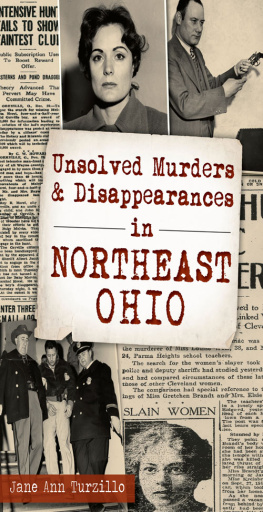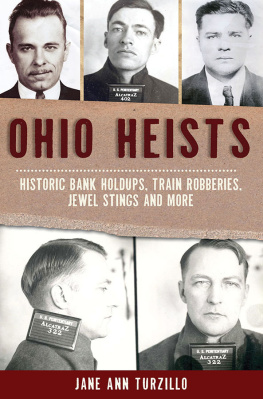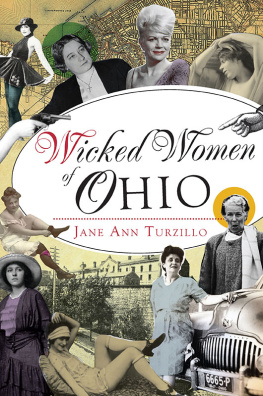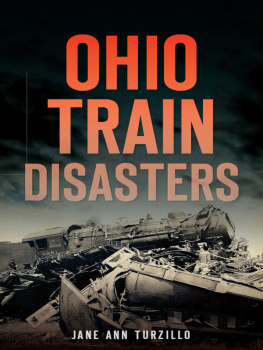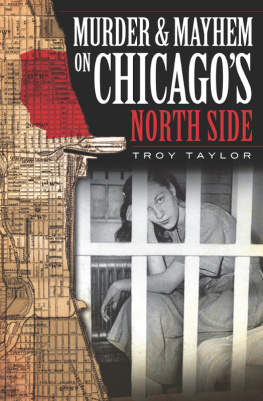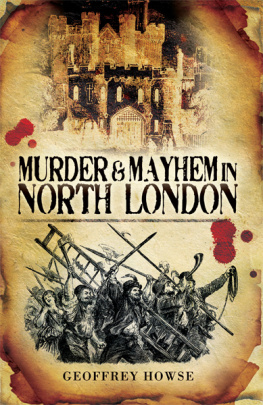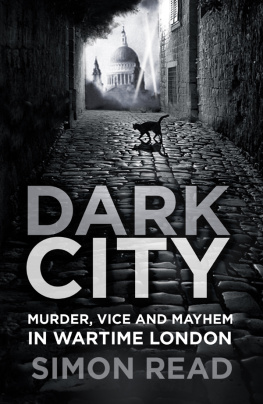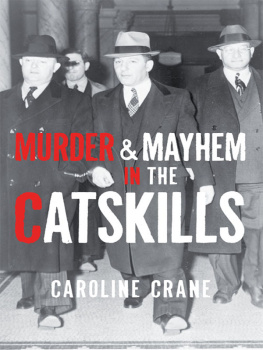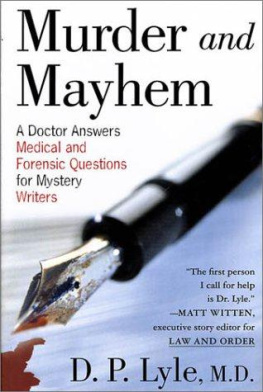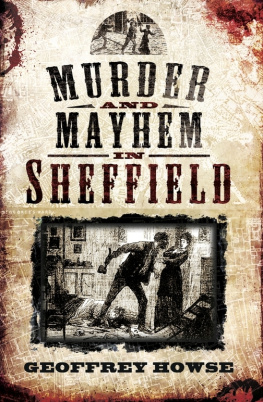Published by The History Press
Charleston, SC 29403
www.historypress.net
Copyright 2014 by Jane Ann Turzillo
All rights reserved
First published 2014
e-book edition 2014
ISBN 978.1.62584.744.7
Library of Congress Cataloging-in-Publication Data
Turzillo, Jane Ann.
Murder and mayhem on Ohios rails / Jane Ann Turzillo.
pages cm
Includes index.
print edition ISBN 978-1-62619-260-7
1. Train robberies--Ohio--Case studies. 2. Murder--Ohio--Case studies. 3. Railroads--Ohio--History. I. Title.
HV6661.O3T87 2013
364.15230922771--dc23
2013046332
Notice: The information in this book is true and complete to the best of our knowledge. It is offered without guarantee on the part of the author or The History Press. The author and The History Press disclaim all liability in connection with the use of this book.
All rights reserved. No part of this book may be reproduced or transmitted in any form whatsoever without prior written permission from the publisher except in the case of brief quotations embodied in critical articles and reviews.
ACKNOWLEDGEMENTS
Writing the acknowledgements is one of my favorite parts of the book. It is here that I get the chance to thank all the folks who helped me put the book together. Without them, there would be no Murder and Mayhem on Ohios Rails.
My first thanks goes to my editor, Greg Dumais, who liked the idea of the book and helped me fine-tune it.
Rich Weller, retired engineer and mechanic for the Indiana & Ohio Railroad and current volunteer engineer and mechanic for the Whitewater Valley Railroad, was always available to answer this greenhorns railroad questions. His help was essential.
As expected, libraries and historical societies proved to be the greatest resources while researching and writing this book. Librarians, archivists and volunteers found newspaper articles and old records. For an attribution and/or a modest donation, many of them allowed me to use their photographs. I am indebted to the following for their assistance: Gwendolyn Mayer, archivist, Hudson Public Library and Historical Society, who always gets me started in the right direction; Toni McPherson, administrative assistant, and Beth Marshall, archivist, Logan County Historical Society Logan County Museum; Melinda Ridgway, reference, Logan County Libraries; Bob Cermak and Scott Wade Stone, Cleveland Police Museum and Historical Society; Darrin Upp, president and curator, Society of Historic Sharonville; Gloria Malone, reference/genealogy, Champaign County Library; Nancy Gillahan, Berea Historical Society; Judi Saurers and Bud Davis, Crestline Historical Society Shunk Museum Archives; Lynn Altstadt, Crestline Public Library; Lynn Duchez Bycko, special collections, Cleveland State University, Michael Schwartz Library; Bob Lyngos, special collections, Alpena County (Michigan) George N. Fletcher Public Library; Christina McVay and Darlene McKenzie, Portage County Historical Society; Holly Hanna, Williams County Public Library Local History Center; Jane Isaacs, public services, Plain City Library; Bernie Vance, Plain City Historical Society; Shalini, Brad, Elizabeth Lang and Albert Hallenberg, information and reference, Public Library of Cincinnati and Hamilton County; Linda Bailey, curator, Cincinnati Museum Center; Richard W. Gross, Greater Cincinnati Police Historical Society Museum; Sue Kienbaum, Marysville Public Library; Angela ONeal, Russ Pollitt and Nick Taggart, genealogy/history/travel, Columbus Metropolitan Library; and Patrice Y. Hamiter and Nicholas Durda, photograph collection, Cleveland Public Library.
I also want to thank Janet Ketchum Armbrust for information on Joe Ketchum, the murdered baggage master. Kit Sempak, whose grandfather was at the Garrettsville station when Alvin Karpis robbed the train there, sent me information on that holdup. Thank you.
Many thanks to the talented Justin Campbell, who did three wonderful illustrations for me, and photo expert Bonnie Janelle for helping me get the photographs ready.
I am grateful to my sister, Mary Turzillo, and my friend and neighbor, Marilyn Seguin. Both have been my writing mentors and my first readers.
My writing buddy, Wendy Koile, got me to submit the idea of a train-robbery book and then provided support and kept me laughingthanks, Wendy! I also want to thank the members of my Sisters in Crime group. Each and every one of them has given me inspiration.
This book was also made possible by those period journalists whose bylines never appeared at the tops of the stories they wrote for Ohio newspapers.
And finally, I want to thank my son, John-Paul Paxton, for his love and encouragement.
I hope I havent forgotten anyone. If I did, it wasnt intentional.
I will miss my Tommy, who laid under my desk while I wrote this book. RIP, boy.
INTRODUCTION
Although most readers are familiar with the train robberies of the Old West and names like Jesse James, Cole Younger, the Reno Brothers, Butch Cassidy and the Sundance Kid and Belle Starr (yes, women got into the act, too), the first peacetime train robbery in the United States happened at North Bend along the Ohio River in Hamilton County, Ohio. The culprits were not famousin fact, they were never caught, so we do not even know their names.
The year was 1865, only weeks after the close of the Civil War and five years before the first western train robbery at Verdi, Nevada, in 1870. Some historians deny North Bend as the location of the first peacetime train robbery because it was on the heels of the war, and they claim guerrillas were responsible.
Alternatively, they give the distinction of the first train robbery to John and Simeon Reno and Franklin Sparks on an Ohio & Mississippi train near Seymour, Indiana, in 1866. When the total of evidence is studied, the North Bend holdup stands the test.
After the war, the railroads saw a monumental growth in Ohio and contributed mightily to the decline of the canals. Trains were faster and could carry more goodsand they carried money in the form of payrolls and well-to-do passengers.
Just as the clatter of the tracks turned some men into wealthy entrepreneurs, it opened up the occupation of train robber. Some of these outlaws became real professionals. Old western movies and TV programs often portrayed masked banditssix-shooters in handjumping from their horses onto moving trains. In Ohio, at least, it did not happen exactly that way.
Instead, the outlaws blew up tracks or dislodged rails to halt or derail a train. This was how the bandits pulled the North Bend train robbery.
Holdup men all wore masks of some variety and brandished guns. The more professional thieves carried dynamite to blow safes. The less experienced thieves depended on obtaining keys from the messengers. Many robbers threw the safes off the moving trains to waiting highwaymen along the route. They would then get off at the next stop and circle back to collect the spoils.
Most robberies occurred at night. At Reese Siding in Williams County, one road agent waved a red lantern in the dark while his pals hid in the woods. When the train ground to a halt, they overpowered the engineer first and then the express messenger who was in charge of the money. The scoundrels dynamited the safe.




